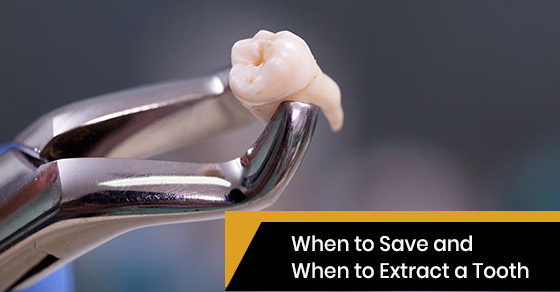
When your tooth gets infected, it might seem like the best decision to get a tooth extraction. However, don’t jump to conclusions so fast. In some cases, there are benefits of saving your natural teeth. Before you decide to save your natural tooth, make sure you know all the facts surrounding your tooth condition.
After a dentist finds an infection within your tooth through an x-ray, a root canal or tooth extraction are two procedures the dentist can perform. Several symptoms can occur, specifying the need for root canal treatment. Before you agree to tooth extraction, let’s take a closer look at when a tooth can be saved.
The first indication of when a tooth can be saved is if the tooth in question is infected by bacteria. But doesn’t the mouth carry millions of harmless bacteria that don’t infect your teeth?
The way harmless bacteria work in the mouth is different. Every day when you eat and drink, dental plaque builds up in your mouth. Over time — if you do not practice proper dental hygiene, such as flossing daily and brushing your teeth after each meal — plaque can grow and cause cavities.
If your diet consists of a lot of sugar, acid forms in your mouth, which can erode your teeth enamel; that’s why dentists say that sugar is bad for your teeth. Cavities must be cleared of decayed material and filled by a dentist.
If you leave cavities untreated, your teeth can decay through the root canals, and this is when your tooth gets infected. Depending on how long you have had the cavity, dentists might be able to save your tooth with a root canal treatment.
Along with cavities, plaque can increase your chance of gum infections that cause chronic inflammation. Inflammation of the gums causes your gums to weaken and your teeth to detach, creating periodontal pockets. These pockets can become infected and cause the bone to deteriorate and loosen the tooth’s position.
Dentists can treat gum disease by performing plaque removal, which enables the infection. After the plaque has been removed and gum inflammation goes away, this gives the tissues in your mouth time to gain strength.
If your tooth is deeply infected and cannot be saved, it’s now time to think about tooth extraction. In cases where the cavity is too large, it compromises the tooth’s structure, making it weak and difficult to repair. Let’s discuss the 5 main reasons why tooth extraction is the solution.
Plaque and tartar build-up causes tooth decay. Tartar and plaque erode the enamel on your tooth, causing them to become brittle and weak. If your tooth gets badly decayed, more than likely, it will cause an infection with redness, swelling, and pain.
Once a tooth gets to this stage of infection, tooth extraction is necessary and can be replaced with a dental bridge to prevent future infection.
Gum disease is similar to tooth decay, as plaque and tartar build-up are the main culprits. In common cases, there are different conditions people develop in the bone surrounding the tooth and the gums, which results in periodontitis and gingivitis.
Periodontitis causes inflammation of tissues and bones surrounding the teeth, while gingivitis causes inflammation of the gums surrounding the teeth. Periodontitis is typically preceded by gingivitis.
In cases where periodontitis or gingivitis causes the bone and the gum around the teeth to deteriorate quickly, the only solution is to get the tooth extracted and replace it with a dental bridge or dental crown to safeguard the other teeth.
Tooth impaction happens when one tooth grows while pushing one tooth against another. This pressure makes the tooth vulnerable to infection, which can cause swollen or bleeding gums. Along with swelling and redness, this condition causes pain, swelling of the jaw, and the inability to open the mouth.
In common cases, tooth impaction is caused by wisdom teeth. Wisdom teeth are the third set of molars located in the back of the mouth that don’t have enough room to grow upright. Instead, wisdom teeth grow inwards, causing the existing teeth to feel the pressure. When wisdom teeth are the culprit to tooth impaction, having the wisdom teeth extracted is the best solution to prevent future damage to existing teeth.
Situations that involve car and sporting accidents cause injuries to the teeth. Whether it has to do with a baseball swiping you in the face or being involved in a car accident, tooth trauma can cause a lot of pain.
Depending on the severity of the accident, the tooth might be too damaged to be saved. For example, if your tooth has been severely cracked and extends below the gum line caused by an accident, tooth extraction may be the only option.
Overcrowding is similar to tooth impaction, where teeth are overcrowding in your mouth. Overcrowding makes straight smiles crooked. The solution to overcrowding is removing the teeth in the back of the mouth to free up some space for the rest of the teeth to grow properly. By removing the back molars and wearing braces, you can get back a well-aligned smile.
As you can see, deciding when you save your tooth and getting it removed requires some consideration.
After your dentist examines your teeth, they can make the appropriate recommendations for extraction. Removing or saving your teeth can be a big decision, and they can help you determine the right choice for you and your dental health.
To learn more about when to save and when to extract a tooth, call Oakville Place Dental at 905-842-6030 or contact us here.
 0 Comment
0 Comment